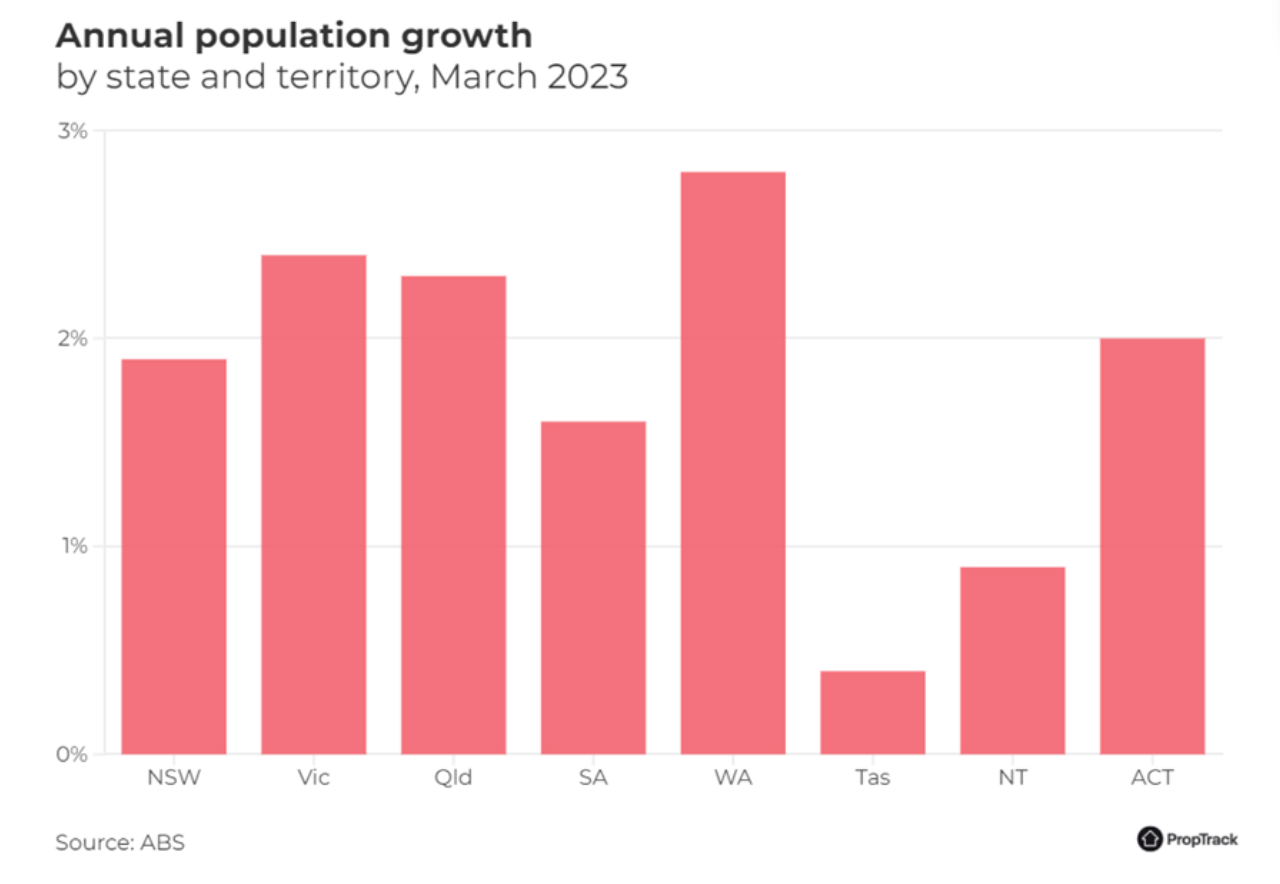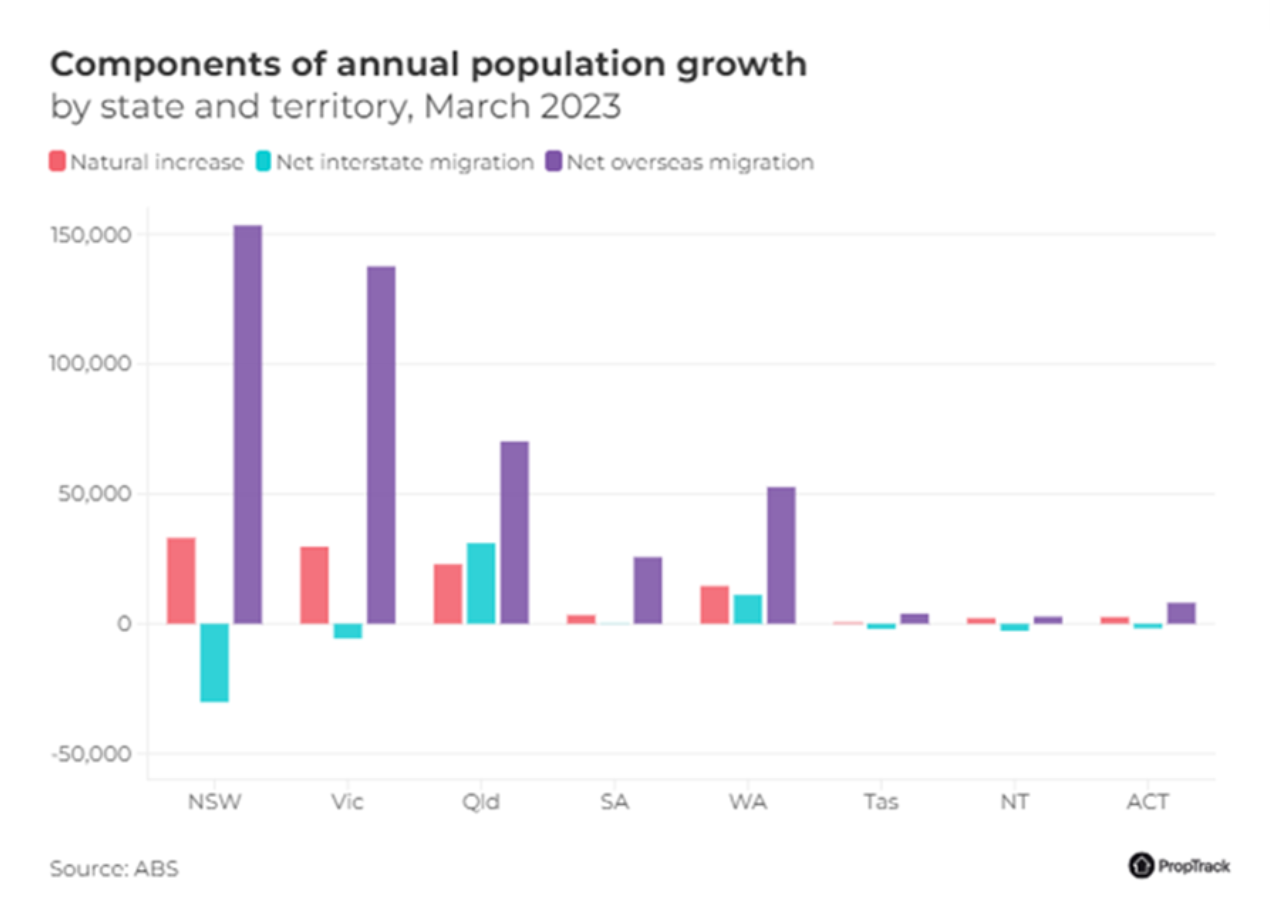
This growth is mainly due to an increase in net migration after our pandemic-related border closures.
In other words, many people, and mainly students, are arriving in Australia and there isn't the usual exodus of students who have finished their term here.
However, this surge in growth emphasises the urgent need for more homes to accommodate the growing population and improved infrastructure to enhance the quality of life in our cities.
According to a recent PropTrack report, in the 2022 calendar year, the population grew by 2.02%, with the majority of that growth driven by record net migration in excess of 400,000 persons.
Eleanor Creagh, Senior Economist at PropTrack commented:
"Prior to the pandemic in the decade to March 2020, the annual population increase through net migration averaged close to 220,000 persons.
But in the two years of pandemic-related disruption, the population increase through net migration was less than 2000 persons across both 2020 and 2021 combined.
Resurgent population growth has continued in 2023, with new data released by the ABS this month showing the pace of growth accelerated.
Population growth jumped to 2.2% in the 12 months to March 2023, while quarterly growth hit 0.7% – the highest national quarterly population increase on record."
The increase was mostly through net overseas migration
Based on ABS data, the increase was mostly through net overseas migration of 454,400 people with fewer departures and a high rate of arrivals, as well as a natural increase of 108,800 in the 12 months to March 2023.

Creagh noted that though the population is growing at a fast pace, the story differs slightly between the states and territories.
Data show that Western Australia has recorded the fastest population growth of the states and territories in the 12 months to March 2023, with a growth of 2.8%.
Meanwhile, Victoria has reversed the Covid-induced falls, recording the largest numeric increase of 161,700 people.
On the other hand, Queensland continues to record strong growth, though the higher growth of the previous year relative to other states was due to the elevated pace of interstate migration, which has begun to ease slightly.
New South Wales is attracting the largest number of people from overseas but continues to lose the most migrants interstate.

Creagh further explained:
"There are many indications the already strong population growth has continued and even accelerated.
If the elevated level of net migration remains, growth in the 12 months to June 2023 will be the largest ever recorded increase.
Based on this, overall annual growth could clock another record of just north of 600,000 persons, with the pace of growth accelerating again to 2.3%."
The Labor Force Survey suggests that our working-age population is still growing at a record rate, now at 2.8% in the year leading up to August 2023.
These numbers show that our population is growing faster than usual right now, but the Intergenerational Report looks at the big picture.
It predicts that over the next 40 years, our population will grow by an average of 1.1% each year, which is slower than the 1.4% growth we've seen over the past 40 years.
This is much less than the current and rising 2.2% growth rate.
Resurgent population growth has been a key factor in bolstering economic activity
If we didn't have this robust growth, the economic slowdown would have been worse.
Skilled migrants have also helped by filling gaps in the workforce.
PropTrack also highlights that even though the timelier indicators show current faster growth has been maintained in 2023, growth is expected to ease in 2024 and 2025.
Creagh said:
"Despite this expected easing ahead, faster-than-expected population growth has meant more people are calling Australia home, giving rise to a mismatch between housing supply and demand.
Given the current housing crisis, the provision of affordable homes remains a critical challenge.
Construction activity has been hampered by higher financing and materials costs and labour shortages, and the value of completed projects has failed to match the value of work in the pipeline.
After reaching a decade low, approvals have begun to turn around as materials shortages and cost pressures ease, the interest rate tightening cycle comes to an end and home prices recover.
Though building activity shows signs of recovery, an undersupply of new homes and an emergent housing shortfall are generating immediate supply issues.
The supply side of the housing market needs to be better able to adjust when needed.
The pickup in population growth also necessitates essential urban infrastructure beyond housing, as well as improved connectivity between cities."
Is there a solution?
According to Creagh, the solutions to the current housing crisis are multi-pronged.
She said that challenges for developers and planning rules are key impediments to growing supply, while infrastructure and investment frameworks are crucial for the liveability of our future cities.
Further, she commented:
"Making use of under utilised space in existing homes is another way to address housing supply, while reducing the need for new construction and the associated environmental impacts.
There is significant well-located spare housing that policy changes could unlock.
As the population surges, a combination of fast-tracking new supply of more of the right type of homes built where people want to live, and policies that encourage better use of existing homes can help ease supply constraints."
Moving forward, it seems clear that demand is going to outstrip supply for some time to come as we continue to experience record levels of immigration at a time when we’re not building as many properties as we require.
At the same time, the cost of construction of delivering new dwellings will keep increasing not only because of supply chain issues and the lack of sufficient skilled labour but because builders and developers will only commence new projects if they are financially viable and currently new projects will need to come on line at considerably higher prices than the current market price.
In other words...property values are only going to keep increasing.